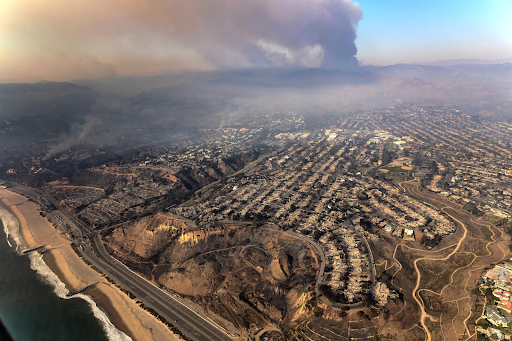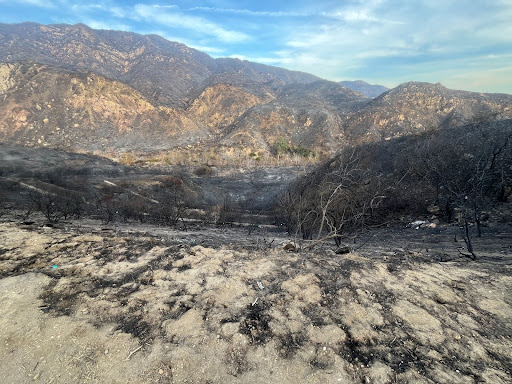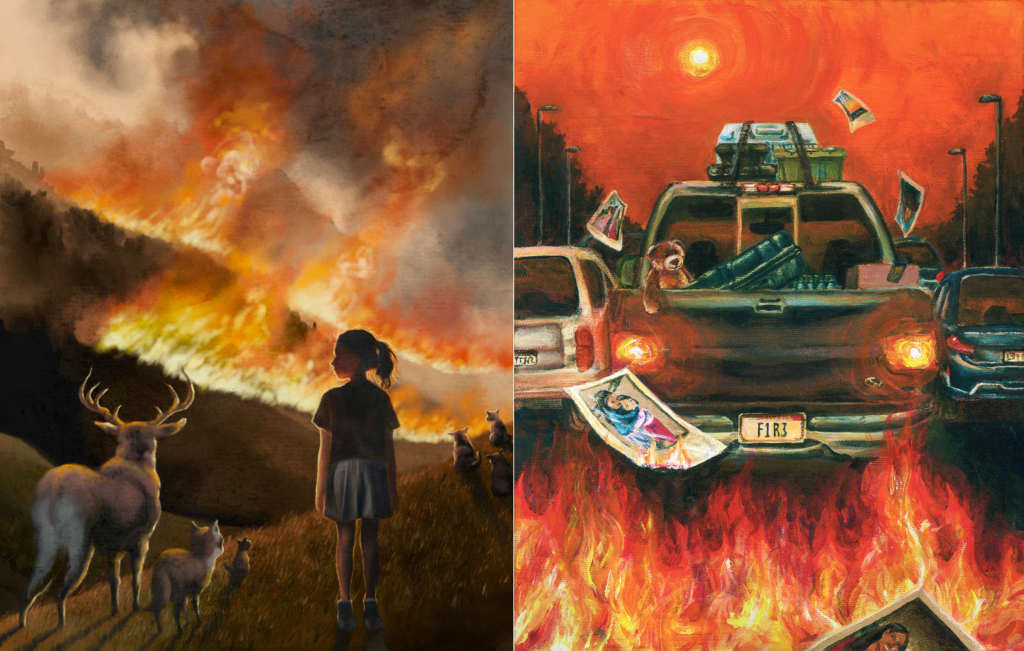
L.A. Inferno: Heat and Heartbreak
January 29, 2025By Gavin Tesser, 2025 Future Blue Youth Council member
Cover photo by ABC News
Los Angeles is burning in a way the city has never seen before. The Eaton and Palisades fires, which erupted earlier this month, have devastated urban areas on an unprecedented scale, scorching almost four square miles of densely populated neighborhoods (AP News). This is the largest urban burning fire in California in over 40 years.
Since the beginning of these fires, 27 lives have been lost, more than 12,000 structures have been reduced to ash, and 80,000 residents have been forced to flee their homes (AP News). While authorities continue to investigate the fire’s origins, experts point to a perfect storm of climate change, urban sprawl, and extreme weather as the culprits.
Historically, wildfires have primarily raged through forests and uninhabited wildlands. However, as urban development sprawls into fire-prone areas, the line between nature and neighborhoods has blurred. Between 1990 and 2020, California saw a 40% increase in homes built in these at-risk zones—areas where vegetation and residential development collide (AP News).
At the same time, climate change is driving extreme weather patterns. Intense droughts, combined with heavy rains that spur vegetation growth, create ideal conditions for fire (AP News). Add to this mix the fierce Santa Ana winds that fanned the flames of the Eaton and Palisades fires, and it’s no surprise that fire crews found themselves overwhelmed (AP News). These fires are estimated to have caused between $250 billion and $275 billion in damages and economic losses, making it one of the costliest wildfire disasters in U.S. history (AccuWeather).
 Los Angeles Times; Destruction of the Palisades Fire
Los Angeles Times; Destruction of the Palisades Fire
I, Gavin Tesser, a Future Blue Youth Council member, was one of these evacuees and have witnessed firsthand the devastation of these fires.
Growing up in Los Angeles, wildfires have always been a concern. This time, though, it hit close to home, like the Woolsey Fire in 2018. As the fires spread, I watched neighborhoods I had driven through countless times vanish in the flames. The fear, the uncertainty, and the helplessness of not knowing what would be left after the fires were unlike anything I could have imagined. I was lucky enough to escape and did not lose anything, but my heart goes out to all those impacted. I will never forget the sight of a smokey sky and knowing how close the danger was. This threat is not just a natural disaster but rather the result of years of ignoring the warning signs of climate change. We have built neighborhoods in once wild areas, and now nature is fighting back in ways we cannot control. But amid the chaos, I also saw something powerful. People came together, offering support, sharing what little they had, and helping neighbors they barely knew. The fires may have destroyed Southern California, but they also remind me that together, we can recover, rise, and protect the planet for future generations. The question now is: will we act quickly enough to meet the urgency of the climate crisis?
 Photo by Gavin Tesser; Destruction of the Franklin Fire in Malibu Canyon
Photo by Gavin Tesser; Destruction of the Franklin Fire in Malibu Canyon
In response to the crisis, local, state, and federal teams are assessing neighborhoods daily, providing resources and support to those affected. The Los Angeles Fire Department is monitoring properties at risk of landslides due to destabilized terrain from firefighting efforts.
These wildfires are a wake-up call about how serious climate change is and why we need to step up with better plans to protect our communities from future disasters. Even with everything they’ve lost, the people of Los Angeles are showing incredible strength and determination to rebuild their lives.
At Bow Seat Ocean Awareness Programs, we aim to get young people involved in protecting the environment through creativity and art, known as “artivism.” The wildfires in LA remind us how connected everything in our environment is and how urgent it is to take action on climate change. Helping youth share their experiences through art and storytelling can inspire the next generation of environmental stewards. Programs like the Ocean Awareness Contest allow students to dive into environmental issues and turn their creativity into meaningful advocacy. By working together and sharing our stories, we can help create a more sustainable future and be better prepared for whatever challenges come our way.
 Left: “Call to Protect” by Evelyn Cho; Right: “Burning Memories” by Katelyn Wong
Left: “Call to Protect” by Evelyn Cho; Right: “Burning Memories” by Katelyn Wong
Works Cited
Danielle, Monica. “AccuWeather Estimates More than $250 Billion in Damages and Economic Loss from LA Wildfires.” AccuWeather, 16 Jan. 2025, https://www.accuweather.com/en/weather-news/accuweather-estimates-more-than-250-billion-in-damages-and-economic-loss-from-la-wildfires/1733821.
“Los Angeles Fires Have Scorched Largest Urban Area in California in at Least 40 Years | AP News.” AP News, AP News, 17 Jan. 2025, https://apnews.com/article/california-los-angeles-wildfires-eaton-palisides-urban-area-a162c86589b9102a85c510246539ab72?utm.com.
Sarnoff, Leah. “Los Angeles Fires: 2nd Blaze Spurs Evacuations – ABC News.” ABC News, ABC News, 8 Jan. 2025, https://abcnews.go.com/US/brush-fires-erupt-los-angeles-life-threatening-wind-dry-weather/story?id=117432009.
“What Happened during the First Weekend of California Fires: Eaton, Palisades – Los Angeles Times.” Los Angeles Times, Los Angeles Times, 11 Jan. 2025, https://www.latimes.com/california/live/2025-01-10/fire-los-angeles-california-eaton-palisades-updates.
